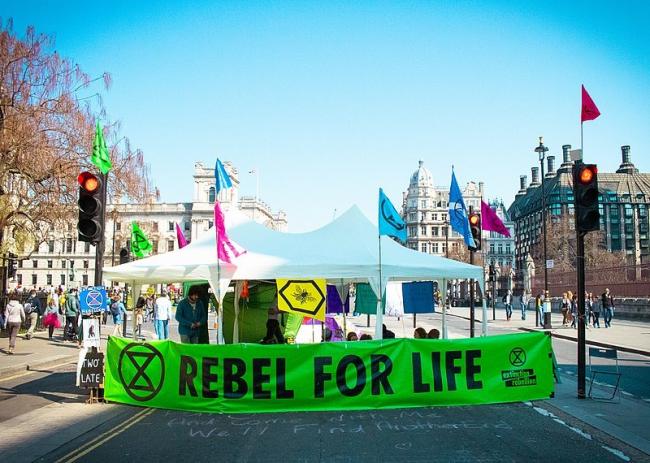Extinction Rebellion targeting London with protests
By Orlando Jenkinson @Lando_jReporter -
Kingston, Epsom, Elmbridge, Richmond, Wandsworth, Croydon

Extinction Rebellion previously staged an occupation of Westminster.

Extinction Rebellion previously staged an occupation of Westminster.
Image: Alexander Savin / wikipedia
Environmental protest group Extinction Rebellion (XR) will stage a series of protests in London starting Monday (Monday, August 23).
The explicitly non-violent group said they plan to target the City of London in particular with two weeks of various demonstrations and direct actions planned, while other protest sites including Trafalgar Square are also likely to emerge.
In a small press release published ahead of Monday's demonstrations, the group described their plan for two weeks of civil disobedience in London as the 'Impossible Rebellion', and said:
"We’re at a crucial moment in history. Our climate is breaking down and life on Earth is dying: accelerated by our economic system and supported by politicians.
"Do you feel powerless to change anything? You are more powerful than you think.
"Join the Rebellion and together we will can make the politically impossible inevitable."
The latest stage in the group's ongoing drive to force governments to take emergency action on the climate crisis comes just days after the United Nations Intergovernmental Panel on Climate Change (IPCC) released a landmark report that laid out the daunting scale of the current climate crisis.
The report called the ongoing heating of the planet caused by fossil fuel use as "unequivocal" and said increasing numbers of extreme weather events like heatwaves, droughts, wildfires, floods and cases of food insecurity were assured in the coming years in Europe and across the globe.
UN General Secretary Antonio Guterres meanwhile called the report "Code Red" for humanity, warning there is precious little time left for humanity to decarbonize the world economy and therefore mitigate the most catastrophic effects of the crisis.
Environmental protest group Extinction Rebellion (XR) will stage a series of protests in London starting Monday (Monday, August 23).
The explicitly non-violent group said they plan to target the City of London in particular with two weeks of various demonstrations and direct actions planned, while other protest sites including Trafalgar Square are also likely to emerge.
In a small press release published ahead of Monday's demonstrations, the group described their plan for two weeks of civil disobedience in London as the 'Impossible Rebellion', and said:
"We’re at a crucial moment in history. Our climate is breaking down and life on Earth is dying: accelerated by our economic system and supported by politicians.
"Do you feel powerless to change anything? You are more powerful than you think.
"Join the Rebellion and together we will can make the politically impossible inevitable."
The latest stage in the group's ongoing drive to force governments to take emergency action on the climate crisis comes just days after the United Nations Intergovernmental Panel on Climate Change (IPCC) released a landmark report that laid out the daunting scale of the current climate crisis.
The report called the ongoing heating of the planet caused by fossil fuel use as "unequivocal" and said increasing numbers of extreme weather events like heatwaves, droughts, wildfires, floods and cases of food insecurity were assured in the coming years in Europe and across the globe.
UN General Secretary Antonio Guterres meanwhile called the report "Code Red" for humanity, warning there is precious little time left for humanity to decarbonize the world economy and therefore mitigate the most catastrophic effects of the crisis.
Deputy Assistant Commissioner, Matt Twist, said: "It is clear to us, from reading and listening to their public announcements that Extinction Rebellion’s intention is to once again cause significant disruption to London and to London’s communities through acts of civil disobedience.
"There have been three previous extended periods of demonstrations by Extinction Rebellion in London. People going about their normal business saw bus routes being diverted or cancelled, significant roads closures, tubes and DLR routes being disrupted by spontaneous demonstrations, and the abstraction of hundreds, if not thousands of officers from their normal duties.
"Like everyone else, Extinction Rebellion have the right to assemble and the right to protest. However these rights are qualified and are to be balanced against the rights of others. They do not have the right to cause serious disruption to London’s communities and prevent them going about their lawful business."
A Met spokesperson added that their officers would "engage with organisers from Extinction Rebellion, hoping to minimise where possible any disruption to London’s communities". Meanwhile, specialist policing teams "who can respond and manage protesters in a safe manner who have built or locked themselves to complicated structures" would be placed on standby.





















